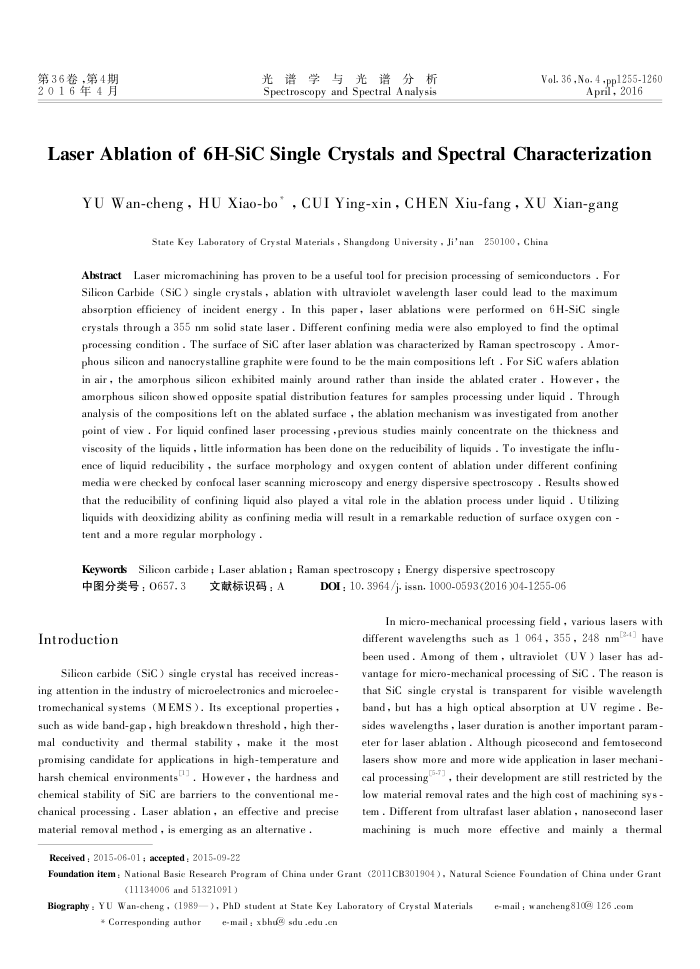您当前的位置:首页>论文资料>6H-SiC单晶的激光刻蚀及光谱分析
内容简介
 第36卷,第4期 2016年4月
第36卷,第4期 2016年4月光谱学与光谱分析 Spectroscopy and Spectral Analysis
Vol. 36 , No. 4 -pp1255-1260
April,2016
LaserAblation of 6H-SiCSingleCrystals and SpectralCharacterization
YU Wan-cheng,HU Xiao-bo",CUIYing-xin,CHEN Xiu-fang,XU Xian-gang
State Key Laboratory of Crystal Materials , Shangdong University , Ji'nan 250100 , China
Abstract Laser micromachining has proven to be a useful tool for precision processing of semiconductors . For Silicon Carbide (SiC ) single crystals , ablation with ultraviolet wavelength laser could lead to the maximum absorption efficiency of incident energy . In this paper, laser ablations were performed on 6H-SiC single crystals through a 355 nm solid state laser. Different confining media were also employed to find the optimal processing condition . The surface of SiC after laser ablation was characterized by Raman spectroscopy - Amor-phous silicon and nanocrystalline graphite were found to be the main compositions left . For SiC wafers ablation in air, the amorphous silicon exhibited mainly around rather than inside the ablated crater . However , the amorphous silicon showed opposite spatial distribution features for samples processing under liquid . Through analysis of the compositions left on the ablated surface , the ablation mechanism was investigated from another point of view . For liquid confined laser processing ·previous studies mainly concentrate on the thickness and viscosity of the liquids , little information has been done on the reducibility of liquids . To investigate the influ-ence of liquid reducibility , the surface morphology and oxygen content of ablation under different confining media were checked by confocal laser scanning microscopy and energy dispersive spectroscopy . Results showed that the reducibility of confining liquid also played a vital role in the ablation process under liquid . Utilizing liquids with deoxidizing ability as confining media will result in a remarkable reduction of surface oxygen con -tent and a more regular morphology .
KeyworsSilicon carbide ; Laser ablation ; Raman spectroscopy ; Energy dispersive spectroscopy
中图分类号:0657.3
Introduction
文献标识码:A
DOI; 10, 3964/j. issn, 1000-0593(2016 )04-1255-06
In micro-mechanical processing field , various lasers with different wavelengths such as 1 064, 355, 248 nm[2-4J have been used. Among of them , ultraviolet (UV ) laser has ad-
Silicon carbide (SiC ) single crystal has received increas-ing attention in the industry of microelectronics and microelec-tromechanical systems (MEMS ). Its exceptional properties , such as wide band-gap , high breakdown threshold , high ther-mal conductivity and thermal stability , make it the most promising candidate for applications in high-temperature and harsh chemical environments). However , the hardness and chemical stability of SiC are barriers to the conventional me-chanical processing . Laser ablation , an effective and precise
material removal method , is emerging as an alternative . Received : 2015-06-01; aceepted: 2015-09-22
vantage for micro-mechanical processing of SiC . The reason is that SiC single crystal is transparent for visible wavelength band, but has a high optical absorption at UV regime . Be-sides wavelengths , laser duration is another important param-eter for laser ablation . Although picosecond and femtosecond lasers show more and more wide application in laser mechani-cal processing[s- , their development are still restricted by the low material removal rates and the high cost of machining sys -tem . Different from ultrafast laser ablation , nanosecond laser machining is much more effective and mainly a thermal
Foundation item : National Basic Research Program of China under Grant (2011CB301904 ), Natural Science Foundation of China under Gran
(11134006 and 51321091)
Biography : YU Wan-cheng , (1989), PhD student at State Key Laboratory of Crystal Materials
Corresponding author
e-mail : xbhu@ sdu .edu .cn
e-mail : wancheng810@ 126 .com
上一章:落叶松树皮活性物质提取及红外光谱分析
下一章:光谱特征分析的城市道路提取